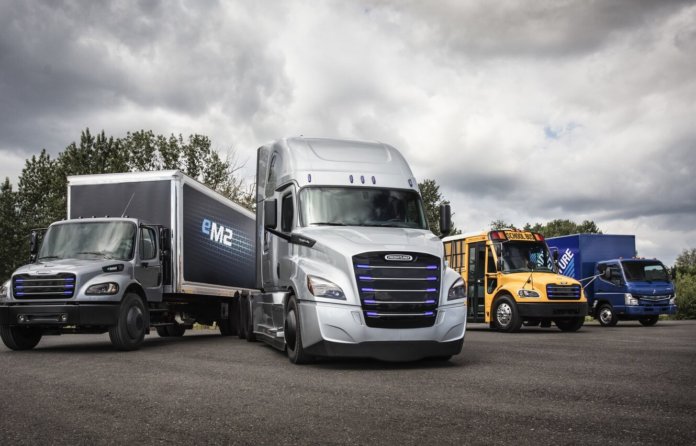
Freightliner Trucks, a division of Portland, Ore.-based Daimler Trucks North America LLC (DTNA), has introduced two fully electrified commercial vehicles, the Freightliner eCascadia heavy-duty truck and the Freightliner eM2 106 medium-duty truck.
The eCascadia has up to 730 peak horsepower. The batteries provide 550 kWh of usable capacity, a range of up to 250 miles and the ability to charge up to 80% (providing a range of 200 miles) in about 90 minutes. The Class 8 tractor is designed for local and regional distribution and drayage.
The eM2 has up to 480 peak horsepower. The batteries provide 325 kWh of usable capacity, a range of up to 230 miles and the ability to charge up to 80% (providing a range of 184 miles) in about 60 minutes. The eM2 is Freightliner’s electrified solution for local distribution, pickup and delivery, food and beverage delivery, and last-mile logistics applications. The Freightliner eCascadia has an 80,000-lb. gross combined weight rating (GCWR), and the eM2 has a 26,000-lb. GCWR.
“The Freightliner eCascadia and eM2 are designed to meet customer needs for electrified commercial vehicles serving dedicated, predictable routes where the vast majority of daily runs fall between 45 and 150 miles,” says Roger Nielsen, president and CEO of DTNA. “These innovative trucks reflect DTNA’s commitment to bring practical, game-changing technology to market. The eCascadia, utilizing North America’s best-selling Class 8 platform, and eM2 106, based on one of the most in-demand medium-duty truck designs, are built on validated, series-production trucks in extensive use by our customers every day.”
The company has a goal of starting series production in 2021. Both vehicles are part of Daimler Trucks’ global electrified truck initiative. The company’s commercial electric vehicles already entering the market include as follows:
- Thomas Built Buses Saf-T-Liner C2 electric school bus, Jouley, with a range of up to 100 miles, starting limited production in 2019.
- More than 100 electric vehicles built by Freightliner Custom Chassis Corp. in 2012 with supplier Electric Vehicles International on the MT-55 walk-in van chassis are still on the road today.
- The FUSO eCanter, a fully electric Class 4 light-duty truck, is being delivered to various customers in North America, Asia and Europe.
- The fully electric Mercedes-Benz Citaro, based on the Mercedes-Benz Citaro, goes into series production in late 2018.
- The Mercedes-Benz eActros is a fully electrified heavy-duty distribution truck starting operations with the first customers in the second half of 2018.
“Our primary goal at DTNA is bringing vehicles to market that are safe, reliable and efficient. Heavy-duty electric vehicles present the greatest engineering challenges, but they also are the best learning laboratories,” Nielsen adds. “We have decades of experience in successfully producing durable commercial vehicles in high volumes that stand up to the demands our customers place on them. We now bring this unmatched experience and expertise to the electric truck category.”





There is more to a vehicle than just its purchase price. An electric truck has fewer moving parts than a diesel, pollutes less which encourages local governments to reduce tolls and license fees, and generally requires less maintenance. Uphill acceleration is better which permits more consistent highway speeds thereby reducing accidents.
Time will tell whether electric trucks make business sense or not. The archaic sight of these huge diesel internal combustion engines compared to a modern compact electric motor makes the decision for me.
Why is it that nobody ever tells us sales prices for those trucks? A price range would do. Lots of stuff is possible – the question is always, will you want to pay for it?